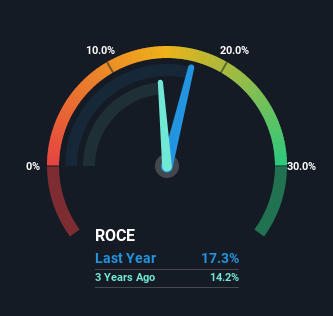If you're looking for a multi-bagger, there's a few things to keep an eye out for. Firstly, we'd want to identify a growing return on capital employed (ROCE) and then alongside that, an ever-increasing base of capital employed. This shows us that it's a compounding machine, able to continually reinvest its earnings back into the business and generate higher returns. That's why when we briefly looked at Metcash's (ASX:MTS) ROCE trend, we were pretty happy with what we saw.
Return On Capital Employed (ROCE): What Is It?
If you haven't worked with ROCE before, it measures the 'return' (pre-tax profit) a company generates from capital employed in its business. Analysts use this formula to calculate it for Metcash:
Return on Capital Employed = Earnings Before Interest and Tax (EBIT) ÷ (Total Assets - Current Liabilities)
0.17 = AU$428m ÷ (AU$5.2b - AU$2.7b) (Based on the trailing twelve months to April 2022).
So, Metcash has an ROCE of 17%. By itself that's a normal return on capital and it's in line with the industry's average returns of 17%.
Our analysis indicates that MTS is potentially undervalued!

Above you can see how the current ROCE for Metcash compares to its prior returns on capital, but there's only so much you can tell from the past. If you'd like to see what analysts are forecasting going forward, you should check out our free report for Metcash.
How Are Returns Trending?
The trend of ROCE doesn't stand out much, but returns on a whole are decent. The company has consistently earned 17% for the last five years, and the capital employed within the business has risen 26% in that time. 17% is a pretty standard return, and it provides some comfort knowing that Metcash has consistently earned this amount. Stable returns in this ballpark can be unexciting, but if they can be maintained over the long run, they often provide nice rewards to shareholders.
Another thing to note, Metcash has a high ratio of current liabilities to total assets of 52%. This effectively means that suppliers (or short-term creditors) are funding a large portion of the business, so just be aware that this can introduce some elements of risk. While it's not necessarily a bad thing, it can be beneficial if this ratio is lower.
The Key Takeaway
To sum it up, Metcash has simply been reinvesting capital steadily, at those decent rates of return. Therefore it's no surprise that shareholders have earned a respectable 93% return if they held over the last five years. So while investors seem to be recognizing these promising trends, we still believe the stock deserves further research.
Metcash does have some risks though, and we've spotted 1 warning sign for Metcash that you might be interested in.
For those who like to invest in solid companies, check out this free list of companies with solid balance sheets and high returns on equity.
New: Manage All Your Stock Portfolios in One Place
We've created the ultimate portfolio companion for stock investors, and it's free.
• Connect an unlimited number of Portfolios and see your total in one currency
• Be alerted to new Warning Signs or Risks via email or mobile
• Track the Fair Value of your stocks
Have feedback on this article? Concerned about the content? Get in touch with us directly. Alternatively, email editorial-team (at) simplywallst.com.
This article by Simply Wall St is general in nature. We provide commentary based on historical data and analyst forecasts only using an unbiased methodology and our articles are not intended to be financial advice. It does not constitute a recommendation to buy or sell any stock, and does not take account of your objectives, or your financial situation. We aim to bring you long-term focused analysis driven by fundamental data. Note that our analysis may not factor in the latest price-sensitive company announcements or qualitative material. Simply Wall St has no position in any stocks mentioned.
About ASX:MTS
Metcash
Operates as a wholesale distribution and marketing company in Australia.
Undervalued with excellent balance sheet.
Similar Companies
Market Insights
Community Narratives



